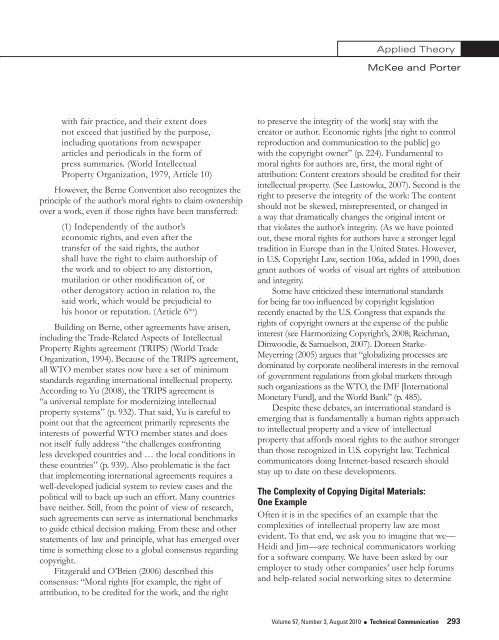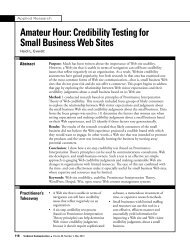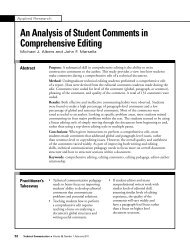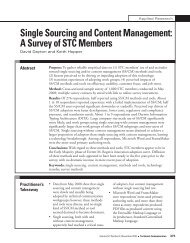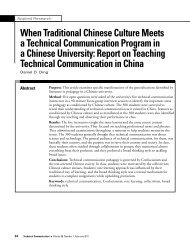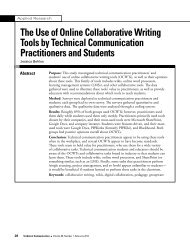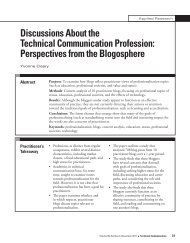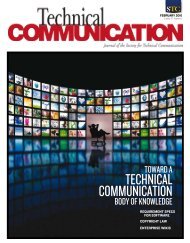Applied TheoryConducting Global Internet Researchtradition known as allemansratten (rights of commonaccess) that allows persons “to walk and even camp onprivately-owned land, as long as they do not harm theland or interfere with the activities of landowners” (p.192). Although originally developed for property issues,the cultural expectations that accompany the rights ofcommon access carry over into intellectual propertyconsiderations for print and digital works.What constitutes harm and interference to land orintellectual property varies from culture to culture (and,within a culture, from legal decision to legal decision).An international ethical perspective examines thesedifferences and reflects on their significance for the useof copyrighted work for purposes of Internet research.This perspective probably works best for limitedcomparisons on a case-by-case basis, but because it iscase-specific, it may be hard to extrapolate to broad(global) circumstances. This is where a global perspective,working in concert with an international perspective, canbe helpful.A global perspective looks at the underlying principlesand legal standards for intellectual property that theinternational community shares, has already developed(e.g., in the Berne Convention, the InternationalCopyright Protection System), and is continuing todevelop. A global perspective does not attempt to effaceor deny differences, although that can be an unintendedconsequence of developing shared standards. Rather, thisperspective acknowledges that if we want to interact andlive in shared spaces, it is important to establish sharedpolicies, customs, regulations, and laws, and to arrive atsome common understandings about how we are goingto live and work together (see Camarce, 2007; Helfer,2007). These emergent global principles and standardscan operate as a kind of benchmark to establishminimum standards and harmonize differences acrossintellectual property regimes.The Universal Declaration of Human Rightsconsiders intellectual property rights to be a fundamentalhuman right:Article 27. (1) Everyone has the rightfreely to participate in the cultural life ofthe community, to enjoy the arts and toshare in scientific advancement and itsbenefits. (2) Everyone has the right tothe protection of the moral and materialinterests resulting from any scientific,literary or artistic production of which heis the author. (United Nations, 1948)Like the U.S. Constitution, with its balance betweenindividual rights and societal good, the UniversalDeclaration of Human Rights recognizes that a balanceis needed—between the “right to the protection ofmoral and material interests” and “the right to…share inscientific advancement and its benefits.”Article 27 can be viewed as an international principleregarding intellectual property—and that principlearticulates a balanced approach to the right of copyrightholders vis-à-vis the rights of the public. However,according to Schultz (2006) and others, this balancehas been “attenuated” in recent years as corporations(particularly in the United States) have used theirinfluence to pass legislation and influence internationalagreements in a way that tips the balance in favor ofstronger copyright protections; for example, lengtheningthe term of copyright (the Sonny Bono Copyright Actof 1998) and criminalizing “unauthorized access” tocopyrighted material (the Digital Millennium CopyrightAct of 1998).Some intellectual property scholars argue that weare in an era of “copyright grab” (Samuelson, 1996) ora “second enclosure movement” (Boyle, 2003). Like theEnglish enclosure movement from the 15th throughthe 19th centuries—which involved fencing off andprivatizing common grazing land—this movementinvolves curtailment of the public right to accessintellectual property, a right that includes the accessrights of researchers to use public information forresearch purposes.In terms of specific laws, beginning with the 1886Berne Convention for the Protection of Literary andArtistic Works, a series of international treaties haveaimed at harmonizing copyright law. Article 10 of themost recently revised Berne Convention articulates ageneral fair use provision that could be said to establish auniversal agreement:It shall be permissible to make quotationsfrom a work which has already beenlawfully made available to the public,provided that their making is compatible292 Technical Communication l Volume 57, Number 3, August 2010
Applied TheoryMcKee and Porterwith fair practice, and their extent doesnot exceed that justified by the purpose,including quotations from newspaperarticles and periodicals in the form ofpress summaries. (World IntellectualProperty Organization, 1979, Article 10)However, the Berne Convention also recognizes theprinciple of the author’s moral rights to claim ownershipover a work, even if those rights have been transferred:(1) Independently of the author’seconomic rights, and even after thetransfer of the said rights, the authorshall have the right to claim authorship ofthe work and to object to any distortion,mutilation or other modification of, orother derogatory action in relation to, thesaid work, which would be prejudicial tohis honor or reputation. (Article 6 bis )Building on Berne, other agreements have arisen,including the Trade-Related Aspects of IntellectualProperty Rights agreement (TRIPS) (World TradeOrganization, 1994). Because of the TRIPS agreement,all WTO member states now have a set of minimumstandards regarding international intellectual property.According to Yu (2008), the TRIPS agreement is“a universal template for modernizing intellectualproperty systems” (p. 932). That said, Yu is careful topoint out that the agreement primarily represents theinterests of powerful WTO member states and doesnot itself fully address “the challenges confrontingless developed countries and … the local conditions inthese countries” (p. 939). Also problematic is the factthat implementing international agreements requires awell-developed judicial system to review cases and thepolitical will to back up such an effort. Many countrieshave neither. Still, from the point of view of research,such agreements can serve as international benchmarksto guide ethical decision making. From these and otherstatements of law and principle, what has emerged overtime is something close to a global consensus regardingcopyright.Fitzgerald and O’Brien (2006) described thisconsensus: “Moral rights [for example, the right ofattribution, to be credited for the work, and the rightto preserve the integrity of the work] stay with thecreator or author. Economic rights [the right to controlreproduction and communication to the public] gowith the copyright owner” (p. 224). Fundamental tomoral rights for authors are, first, the moral right ofattribution: Content creators should be credited for theirintellectual property. (See Lastowka, 2007). Second is theright to preserve the integrity of the work: The contentshould not be skewed, misrepresented, or changed ina way that dramatically changes the original intent orthat violates the author’s integrity. (As we have pointedout, these moral rights for authors have a stronger legaltradition in Europe than in the United States. However,in U.S. Copyright Law, section 106a, added in 1990, doesgrant authors of works of visual art rights of attributionand integrity.Some have criticized these international standardsfor being far too influenced by copyright legislationrecently enacted by the U.S. Congress that expands therights of copyright owners at the expense of the publicinterest (see Harmonizing Copyright’s, 2008; Reichman,Dinwoodie, & Samuelson, 2007). Doreen Starke-Meyerring (2005) argues that “globalizing processes aredominated by corporate neoliberal interests in the removalof government regulations from global markets throughsuch organizations as the WTO, the IMF [InternationalMonetary Fund], and the World Bank” (p. 485).Despite these debates, an international standard isemerging that is fundamentally a human rights approachto intellectual property and a view of intellectualproperty that affords moral rights to the author strongerthan those recognized in U.S. copyright law. Technicalcommunicators doing Internet-based research shouldstay up to date on these developments.The Complexity of Copying Digital Materials:One ExampleOften it is in the specifics of an example that thecomplexities of intellectual property law are mostevident. To that end, we ask you to imagine that we—Heidi and Jim—are technical communicators workingfor a software company. We have been asked by ouremployer to study other companies’ user help forumsand help-related social networking sites to determineVolume 57, Number 3, August 2010 l Technical Communication 293
- Page 1 and 2: AUGUST 2010Volume 57 Number 3SPECIA
- Page 3 and 4: PresidentMichael A. HughesVice Pres
- Page 5 and 6: VoLuME 57, NuMBER 3AUGUST 2010ISSN
- Page 7 and 8: Guest EditorialKirk St.Amant and Ma
- Page 9 and 10: Applied ResearchTechnical Communica
- Page 11 and 12: Applied ResearchNicole St. Germaine
- Page 13 and 14: Applied ResearchNicole St. Germaine
- Page 15 and 16: Applied ResearchNicole St. Germaine
- Page 17 and 18: Applied ResearchNicole St. Germaine
- Page 19 and 20: Applied ResearchNicole St. Germaine
- Page 21 and 22: Applied ResearchNicole St. Germaine
- Page 23 and 24: Applied ResearchNicole St. Germaine
- Page 25 and 26: Applied TheoryTatiana BatovaIntrodu
- Page 27 and 28: Applied TheoryTatiana BatovaMoreno,
- Page 29 and 30: Applied TheoryTatiana BatovaThe Uni
- Page 31 and 32: Applied TheoryTatiana Batovadoctors
- Page 33 and 34: Applied TheoryTatiana BatovaTo addr
- Page 35 and 36: Applied TheoryTatiana Batovathe loc
- Page 37 and 38: Applied TheoryTatiana BatovaJohnson
- Page 39 and 40: Applied TheoryTatiana BatovaInterna
- Page 41 and 42: Applied TheoryMcKee and PorterIntro
- Page 43 and 44: Applied TheoryMcKee and PorterFor e
- Page 45 and 46: Applied TheoryMcKee and Porterpubli
- Page 47 and 48: Applied TheoryMcKee and PorterBecau
- Page 49: Applied TheoryMcKee and Porterof th
- Page 53 and 54: Applied TheoryMcKee and PorterA Cop
- Page 55 and 56: Applied TheoryMcKee and PorterConte
- Page 57 and 58: Applied TheoryMcKee and PorterWalto
- Page 59 and 60: Applied ResearchLiza PottsIntroduct
- Page 61 and 62: Applied ResearchLiza Pottsdoes not
- Page 63 and 64: Applied ResearchLiza PottsUser’s
- Page 65 and 66: Applied ResearchLiza Pottsactors, t
- Page 67 and 68: Applied ResearchLiza PottsDRM has a
- Page 69 and 70: Applied ResearchLiza Pottsmake bett
- Page 71 and 72: Applied ResearchLiza PottsOne viewe
- Page 73 and 74: Applied ResearchLiza Pottsinvolved
- Page 75 and 76: Applied ResearchLiza PottsHayhoe, G
- Page 77 and 78: Applied ResearchInternational Fair
- Page 79 and 80: Applied ResearchTyAnna K. Herringto
- Page 81 and 82: Applied ResearchTyAnna K. Herringto
- Page 83 and 84: Applied ResearchTyAnna K. Herringto
- Page 85 and 86: Applied ResearchTyAnna K. Herringto
- Page 87 and 88: Applied ResearchTyAnna K. Herringto
- Page 89 and 90: Book ReviewsWriting Successful Scie
- Page 91 and 92: Book ReviewsThe Process: Business P
- Page 93 and 94: Book ReviewsHCI Beyond the GUI: Des
- Page 95 and 96: Book ReviewsOrigins of the Specious
- Page 97 and 98: Book Reviewsgenre, and process, top
- Page 99 and 100: Book ReviewsPart One goes from the
- Page 101 and 102:
Book Reviewsrather than writers, an
- Page 103 and 104:
Book ReviewsHow to Write Fast Under
- Page 105 and 106:
Book Reviewsmanagement system (CMS)
- Page 107 and 108:
Book Reviewsnearly strangled when h
- Page 109 and 110:
Book Reviewsinteractive TV model)
- Page 111 and 112:
Book ReviewsOtherwise, Beech shows
- Page 113 and 114:
Book Reviewssuch as blog, I found m
- Page 115 and 116:
Book Reviewsemployees and effective
- Page 117 and 118:
Recent & RelevantSherry Southard, E
- Page 119 and 120:
Recent & RelevantRecent & RelevantC
- Page 121 and 122:
Recent & RelevantRecent & RelevantE
- Page 123 and 124:
Recent & Relevantworking in a langu
- Page 125 and 126:
Recent & RelevantWhat’s the big d
- Page 127 and 128:
Recent & RelevantScientific Writing
- Page 129 and 130:
Recent & Relevantapplicability. Man
- Page 131:
Did You Missthe Summit?Don’t miss


